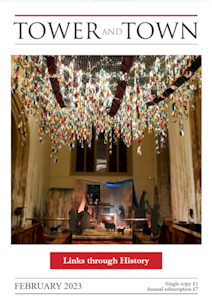

Tower and Town, February 2023 (view the full edition) (view the full edition)The Naming of Trees in SavernakeOne local result of Covid was the significant increase in visitors to Savernake Forest. Paths that were mere suggestions became well worn, and new paths opened up to become similarly obvious. It was on one delightful amble discovering several new variations that I realised my current Savernake Forest Map (available at White Horse Bookshop, St Peter's Church and Postern Hill caravan site) was becoming seriously out of date, especially as two more cattle grazing areas had been fenced since its publication. It was time to produce the next edition, and as I pondered the history of Savernake I realised that there was nothing anywhere in the forest to commemorate the family that had been wardens and then owners of the estate for some 950 years. Wasn't that worth recording somewhere? The answer suddenly became obvious as I passed the Marie-Louise Oak and asked myself: 'Who was Marie-Louise?' Research tentatively suggested that she could have been the Duchess of Parma, Napoleon's second wife, who is known to have visited Bath and would inevitably have rested at a fine house and estate half way along the bumpy road from London; and what finer than Tottenham House on Savernake estate. And would not her host, Thomas Brudenell-Bruce (Marquis of Ailesbury), have proudly shown her his Capability Brown designed forest and rides; and perhaps, as she expressed her delight, he named the track they rode in her honour: Marie-Louise Ride, and subsequently, the tree itself? Or perhaps Marie-Louise was just a family friend... or the horse! That tree's name however reminded me that some of Savernake's mighty oaks, part of history themselves, also record snippets of human history too. This idea could be extended. (The Marie-Louise Oak-see picture.) With the permission of Forestry England and the approval of Lord Cardigan, whose ancestors were the wardens and owners since 1067, his long established Savernake connection is now recorded in the names of trees; and as the surname changed three times through female inheritance and marriage, four great oaks now perpetuate that history:
During those recent discussions, three non-historic tree names were also added, Troll and Goblin, and Young Paunchy, an obvious pairing with Old Paunchy not far away, giving a nice total of 32 named oaks for visitors to seek out, and all now appearing on the latest map (5th edition). But how would visitors recognise these added trees? While involved in my map-making and discussions, it was a very pleasant surprise to discover that local architectural technician and Savernake enthusiast, Kieren Dobie, as a very competent sign maker, had been quietly restoring damaged tree signs or replacing the missing ones, and matching Forestry England's own signs perfectly. We both realised that while the map might direct visitors in the right direction, Kieren's signs would prove their arrival, and he was keen to add the new names to his project. But though the significance of many names allocated to the twenty-six earlier is understood, it remains a mystery who allocated them and when, and in some cases why. 
Peter Noble |